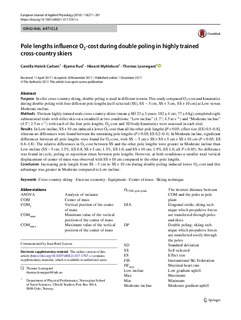| dc.contributor.author | Carlsen, Camilla Høivik | |
| dc.contributor.author | Rud, Bjarne | |
| dc.contributor.author | Myklebust, Håvard | |
| dc.contributor.author | Losnegard, Thomas | |
| dc.date.accessioned | 2018-04-13T11:24:15Z | |
| dc.date.available | 2018-04-13T11:24:15Z | |
| dc.date.created | 2017-12-12T08:50:00Z | |
| dc.date.issued | 2017 | |
| dc.identifier.citation | European Journal of Applied Physiology. 2017, 118, 271-281 | nb_NO |
| dc.identifier.issn | 1439-6319 | |
| dc.identifier.uri | http://hdl.handle.net/11250/2494070 | |
| dc.description | This article is an open access publication. | nb_NO |
| dc.description.abstract | Purpose: In elite cross-country skiing, double poling is used in different terrain. This study compared O2-cost and kinematics during double poling with four different pole lengths [self-selected (SS), SS − 5 cm, SS + 5 cm, SS + 10 cm] at Low versus Moderate incline. Methods: Thirteen highly trained male cross-country skiers (mean ± SD 23 ± 3 years; 182 ± 4 cm; 77 ± 6 kg) completed eight submaximal trials with roller skis on a treadmill at two conditions: “Low incline” (1.7°; 4.5 m s−1) and “Moderate incline” (4.5°; 2.5 m s−1) with each of the four pole lengths. O2-cost and 3D body kinematics were assessed in each trial. Results: In Low incline, SS + 10 cm induced a lower O2-cost than all the other pole lengths [P < 0.05; effect size (ES) 0.5–0.8], whereas no differences were found between the remaining pole lengths (P > 0.05; ES 0.2–0.4). In Moderate incline, significant differences between all pole lengths were found for O2-cost, with SS − 5 cm > SS > SS + 5 cm > SS + 10 cm (P < 0.05; ES 0.6–1.8). The relative differences in O2-cost between SS and the other pole lengths were greater in Moderate incline than Low incline (SS − 5 cm; 1.5%, ES 0.8, SS + 5 cm; 1.3%, ES 1.0, and SS + 10 cm; 1.9%, ES 1.0, all P < 0.05). No difference was found in cycle, poling or reposition times between pole lengths. However, at both conditions a smaller total vertical displacement of center of mass was observed with SS + 10 cm compared to the other pole lengths. Conclusion: Increasing pole length from SS − 5 cm to SS + 10 cm during double poling induced lower O2-cost and this advantage was greater in Moderate compared to Low incline. | nb_NO |
| dc.language.iso | eng | nb_NO |
| dc.subject | cross-country skiing | nb_NO |
| dc.subject | exercise economy | nb_NO |
| dc.subject | equipment | nb_NO |
| dc.subject | center of mass | nb_NO |
| dc.subject | skiing technique | nb_NO |
| dc.title | Pole lengths influence O2-cost during double poling in highly trained cross-country skiers | nb_NO |
| dc.type | Journal article | nb_NO |
| dc.type | Peer reviewed | nb_NO |
| dc.description.version | publishedVersion | nb_NO |
| dc.rights.holder | © The Author(s) 2017 | nb_NO |
| dc.source.pagenumber | 271-281 | nb_NO |
| dc.source.volume | 118 | nb_NO |
| dc.source.journal | European Journal of Applied Physiology | nb_NO |
| dc.source.issue | 2 | nb_NO |
| dc.identifier.doi | 10.1007/s00421-017-3767-x | |
| dc.identifier.cristin | 1526038 | |
| dc.description.localcode | Seksjon for fysisk prestasjonsevne / Department of Physical Performance | nb_NO |
| cristin.unitcode | 150,31,0,0 | |
| cristin.unitname | Seksjon for fysisk prestasjonsevne | |
| cristin.ispublished | true | |
| cristin.fulltext | original | |
| cristin.qualitycode | 1 | |
